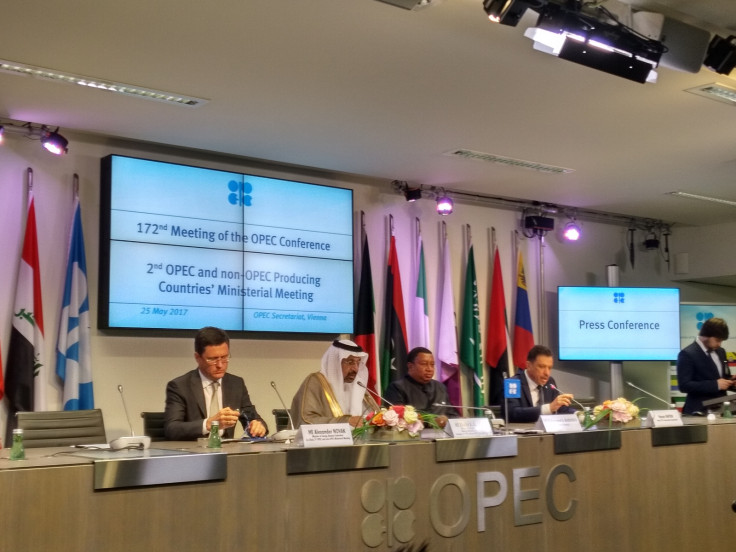Oil futures hammered as Opec and non-Opec producers' predictable output cut extension triggers selloff
Russian and Saudi oil ministers broker deal between 24 producers to extend their ongoing output cuts.

Opec and 10 non-Opec oil producers decided to extend their collective production cuts of 1.8m barrels per day (bpd) by another nine months to March 2018, following the conclusion of their meeting in Vienna, Austria on Thursday (25 May), sending oil benchmarks sliding by over 4%.
With an Opec and non-Opec cut largely priced in by the market, the formal announcement triggered a market selloff. At 5:32pm BST, the Brent front month futures contract fell by 4.02% or $2.01 to $51.80 per barrel.
Concurrently, the West Texas Intermediate slid below the psychological $50 per barrel level, down by 4.34% or $2.23 to $49.13%.
Saudi Energy Minister Khalid Al-Falih said the decision was the optimal choice following deliberations aimed at rebalancing the market and bringing inventory levels down to five-year average levels.
"There are number of oil market variables which could play out over the course of the second half of the year. We will be monitoring the situation and stand ready to respond."
Al-Falih also said Opec needs to be evolve, work and coexist with other producers.
"It's not a confrontation between Opec and US shale producers, there is room for everyone in the market to replace legacy basins.
"Only problem we have with shale is pace of the increase of production, which cannot be extrapolated by them forever. There remains a great deal of uncertainty with shale, and like conventional oil production, output rates will decline."
He added that Russia and Saudi Arabia are "catalysing" the balancing of the market.
For his part, Russian Energy Minister Alexandaer Novak said compliance with Opec and non-Opec cuts had been very positive and a decision to roll over the cuts for "few more months" was the natural thing to do.
"Russia has reached full conformity with its pledged output reduction of 300,000 bpd as have other non-Opec partners. We will continue to monitor the situation."
Earlier in a joint statement, Opec and the 10 participating non-Opec producers said they will "continue to regularly review the status of their cooperation" at the technical and ministerial levels, and further agreed to continue to strengthen their cooperation.
Little surprise in the market
Andy Brogan, Global Oil & Gas Transactions Leader at EY, said there was little surprise in the market over the decision. "Overall, compliance with production cuts has been strong so far but could weaken in the second half of the year. Some countries brought forward field maintenance to the first half of the year.
"Output from these fields will need to ramp up as the year goes on, however, to maintain reserves. The decision taken on Thursday should provide support to oil prices and sustain the shale recovery. The possible downside is that the increased activity could lead to inflation in costs and services. Companies will need to ensure that inflation does not exceed efficiency gains."
Sam Wahab, Director of Oil & Gas Research at Cantor Fitzgerald Europe, said regardless of Opec's decision, its ability to control oil price had been 'diluted' by US and non-Opec production.
"Following the meeting, we have seen both Brent and WTI trading lower on the news as a proportion of the market had priced in the potential for deeper cuts. However, this failed to materialise – a case of buying on rumour and selling on facts.
"There seems to be a little resistance on the price at $55, but if Opec members and a selection of non-Opec members - notably Russia - abide by the supply cut, the price could conceivably hit $60 by year end. The key risk to the downside continues to stem from growing US production, which threatens to replace the cut in supply from Saudi/Russia."
© Copyright IBTimes 2025. All rights reserved.






















